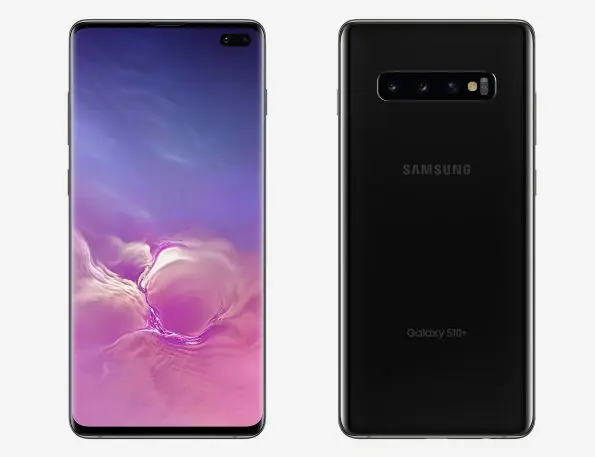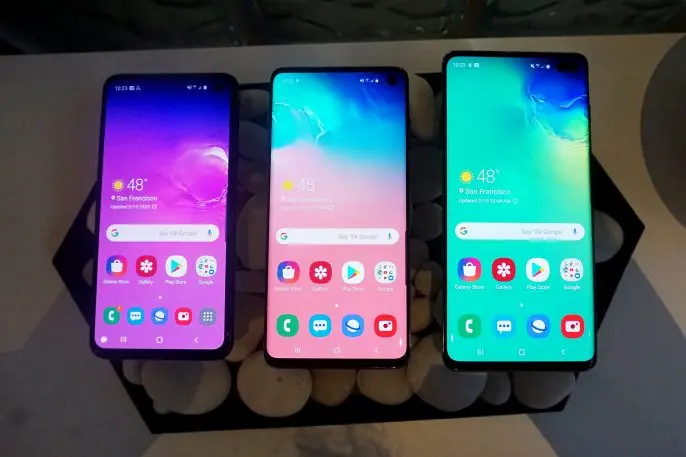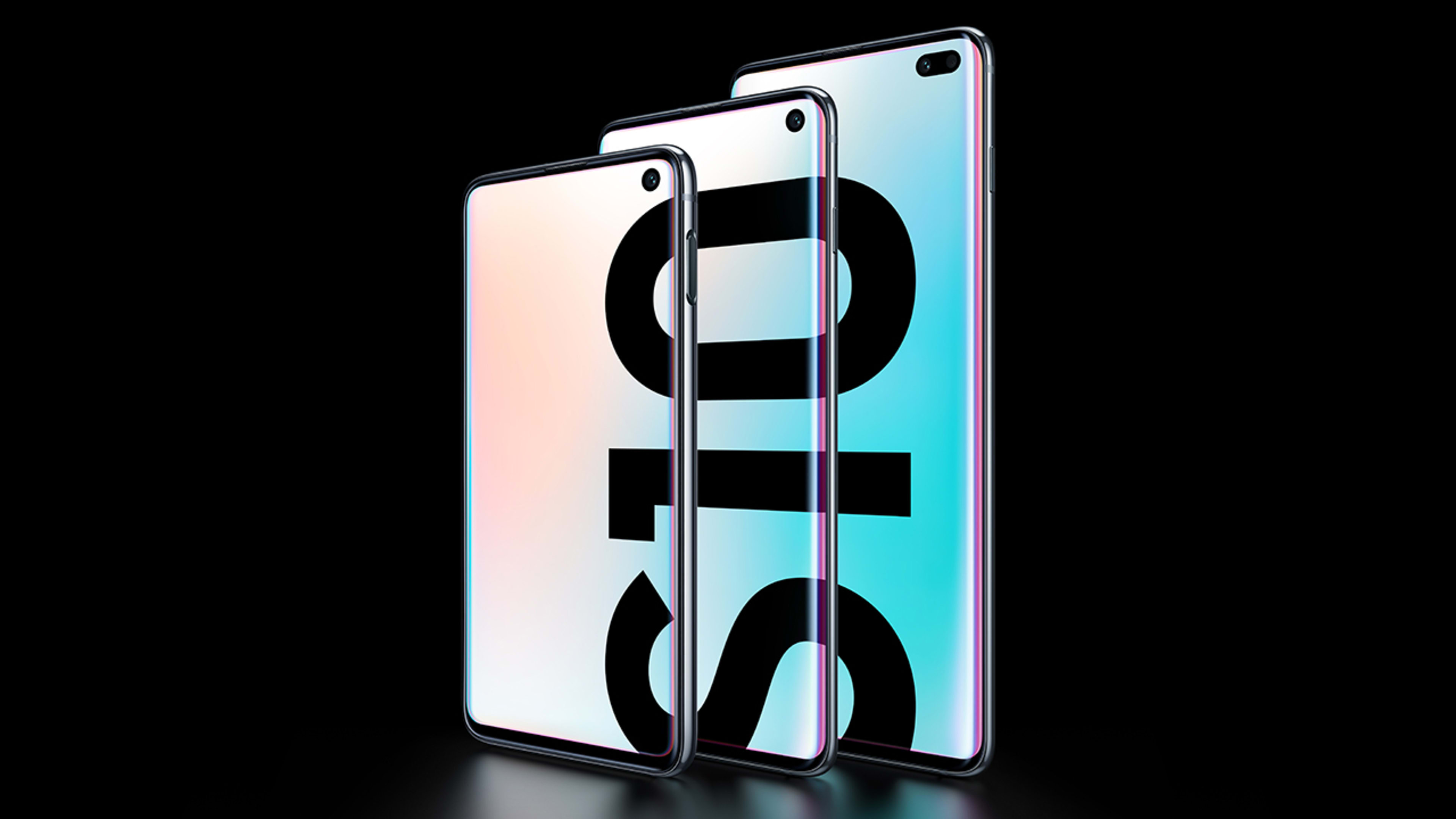As recently as 2014, Samsung’s big annual Galaxy S smartphone launch extravaganza featured a single smartphone–that year, the Galaxy S5. Then the company started unveiling two Galaxy S models at its bashes: a flagship model and a super-flagship. Last year they were the Galaxy S9 and S9+, which were essentially the same phone in two sizes.
Times have changed. On Wednesday, at its “Unpacked” event at San Francisco’s Bill Graham Auditorium, Samsung began by revealing its Galaxy Fold, a smartphone that unfolds into a tablet and–at $1,980–seems aimed at the most hardcore of gadget fetishists. And then it walked through four new Galaxy S phones: the Galaxy S10, S10+, S10e, and S10 5G. Though recognizable as variants of the same brand promise, with the same aesthetic and many shared features, they’re distinct enough that the move feels like a fundamental shift. Now the Galaxy S is about choice–and not just choice between a big phone and an even bigger one.
DJ Koh, CEO of Samsung Electronics’ IT and mobile communications division, says that the expansion is a meaningful effort to please more people than if the company had released a couple of models as in the past. “We are trying to listen to the broad range of customers–their needs and their demands,” he tells me when I speak with him and senior VP of mobile marketing, Justin Denison, on Tuesday as part of a briefing at which I got a little hands-on time with the S10, S10+, and S10e, all of which are available for preorder starting on Thursday and go on sale March 8. (Samsung did not have an S10 5G on hand or disclose precisely when it will ship.)
Samsung’s move follows Apple’s introduction of three new iPhone X models last fall. In both cases, customers end up with more options, but must also perform more mental callisthenics before making a purchase. And it feels like at least some of the same dynamics prompted both Samsung and Apple to build out their lineups.
For one thing, both companies are aiming to get some of their customers paying higher prices for the most fully loaded phones ever. Last year’s Galaxy S9 had a starting price of $720; this year’s Galaxy S10 starts at $900. The Galaxy S9+, meanwhile, started at $840 while the Galaxy S10+ starts at $1,000.
These increases are by no means a pure profit grab by Samsung. The 2019 models are packed with improvements and new technologies, starting with their screens. They sport the latest version of Samsung’s AMOLED technology, which the company calls Dynamic AMOLED. It features certified support for the HDR10+ standard for blacker blacks, whiter whites, and a vivid range of colors in between. It’s also designed to reduce harmful blue light and deliver true colors in outdoor light.
The Galaxy S8 and S9 featured Samsung’s “Infinity Display” screen, which curved right off the left and right sides of the phone but still had a fair amount of bezel at top and bottom–especially since the company chose to opt out of the notch fad. With the new models, Samsung managed to put the proximity and light sensors under the display and isolated the front-facing camera in a small cut-out near the upper right-hand corner of the screen, allowing it to come closer than ever to a true all-screen design. For the record, I’ve been carrying an iPhone X for well over a year and have never found the notch a distraction or an aesthetic faux pas. Even so, Samsung’s “hole punch” cutout is an elegant, space-efficient alternative.

Did I refer to a front-facing camera, singular? The S10+ has both a standard selfie camera and an RGB camera on its front, letting it blur backgrounds more artfully and necessitating a wider two-camera hole punch. On the back, both the S10 and S10+ have three cameras: wide-angle and 2X zoom models like last year, plus a new ultra-wide angle camera that approximates what the human eye sees and is especially well-suited to landscapes and street photography.
Samsung has also addressed one of the most glaring weaknesses of its last couple of generations of Galaxy S models by giving the S10 and S10+ a new fingerprint sensor that sits on the front of the phone–but under the display, so it doesn’t compete with the screen for space. The sensor uses ultrasonic technology, which the company says makes for more accurate detection by capturing a 3D image of your finger or thumb. And it should be easier to use than the backside scanners on recent Galaxy models, which can be tough to find with your fingertip (and occasionally leave you smudging the camera lens). Samsung is confident enough in its new fingerprint scanner that it’s ditched the iris-scanning feature from previous models, which rarely worked well for me. (A face-scanning option remains.)
The company says that the new S10 models are the industry’s first phones to shoot video in HDR10+ and to support the new wireless standard known as Wi-Fi 6 (802.11ax to you geeks). It also added a feature called Wireless PowerShare that lets you charge Qi-compatible devices such as its own Galaxy Buds, Galaxy Fit, and Galaxy Watch Active wearables, and other smartphones by touching them to the back of a Galaxy S10; it seems like a killer feature for those with the gadgets in question, and one that Apple fans might envy. (I even successfully used it to charge my iPhone X.)
Along with everything that’s new, the S10 and S10+’s higher price points can also be explained in part by something that’s missing: Samsung got rid of last year’s entry-level models with 64GB of storage. 128GB is now standard, with 512GB as an option. The S10+ is also available in a super-premium edition with 1TB of space and a ceramic case. That will set you back $1,600, which is $150 more than the priciest version of the iPhone XS Max.
E for “entry level”
Even if the S10 and S10+ give you meaningfully more stuff than their 2018 predecessors, Samsung needs a Galaxy S model for people who aren’t about to plunk down at least $900 for their next smartphone. Enter the Galaxy S10e, which starts at $750 and occupies a spot in the lineup roughly akin to the iPhone XR, Apple’s most affordable new iPhone.
If the new $900 Galaxy S10 didn’t exist, Samsung could easily have gotten away with calling the S10e the S10; it’s got the nice new hole-punch display at a 5.8-inch size and generally looks like an improvement on the S9 on multiple fronts. But it does delete a few S10 features to hit its price point. For instance, it has a fingerprint scanner on its edge rather than the nifty under-the-screen version. And it has only two cameras on its rear, not three.
Samsung, incidentally, says that the S10e isn’t purely about having something for people who aren’t going to pay $900 for a Galaxy S10 or $1,000 for a Galaxy S10+; about a quarter of consumers prefer a relatively compact phone, even if they sacrifice some screen real estate.
That leaves the Galaxy S10 5G. We already knew that Samsung would announce a model supporting high-speed 5G wireless. But the S10 5G isn’t just a Galaxy S10 with a 5G antenna. At 6.7 inches, it has the largest screen of any Galaxy S model–it’s even a skosh more spacious than the Galaxy Note 9. The S10 5G will come in a single version with 256GB of storage, and won’t have the MicroSD memory expansion slot and dual SIM capacity available on the other new S10 models.
Most intriguingly, the Galaxy S10 5G has 3D-depth cameras on both its front and back, giving it an understanding of real-world space that’s useful for augmented-reality apps. By beefing up the S10 5G’s world-sensing capabilities, Samsung is betting that the arrival of 5G will be good for AR: “We’re allowing people to develop those 5G applications that take advantage of depth-camera technologies, such as AR gaming, which we believe will be a really interesting use case for consumers,” says Denison.
With 5G still barely available–as a San Franciscan, I’d have to drive 90 minutes up north to Sacramento to get even a whiff of it–and sophisticated AR not yet much of a factor on smartphones, the Galaxy S10 5G is about potential as much as anything else. (Nobody expects Apple, which tends to shy away from bleeding-edge technology, to release a 5G iPhone until late 2020.) It will be available as a Verizon exclusive in the first half of the year, at a price to be announced, with other carriers coming aboard later in 2019.
Still, by choosing to hop on the 5G bandwagon early, Samsung is getting some engineering challenges out of the way that every phone manufacturer is in the process of tackling. Nine months ago, the company’s engineers brought Koh an early prototype of the S10 5G. “I never yell in my meetings, but I said, frankly, to my colleagues, ‘I’m disappointed,'” he recounts. “It was too thick.” Two or three months after that, they returned with a version more to his liking: At 7.94mm, the S10 5G is ever so slightly thicker than the other new S10 models, but meaningfully thinner than last year’s S9 and S9+.
Squeezing 5G into an attractively svelte phone matters, but it’s only a tiny step for the technology. “Over the last 10 years, the smartphone was pretty much in the center,” Koh says. “In the 4G era, that was quite natural.” Like others in the tech industry, he’s setting the bar high by talking about 5G in epoch-shifting terms, saying that it will enable a fourth industrial revolution that could change the world in a way that 4G, 3G, and previous flavors of wireless did not.
“It’s not just the IT industry and smartphones,” he says. “It will be automobiles, factories, even cities. That’s the reason I’m very, very excited about 2019. And 2020 will be a turning point of another exciting decade of progress and innovation.”
Billions for Bixby
For as long as Samsung has been making Galaxy S phones, it’s struggled with the fact that it’s never been anywhere near as good at software as it is at hardware. The company’s rejiggering of standard Android functionality and original features such as AR Emoji have sometimes come off more as annoying than innovative.
With this year’s phones, however, Samsung seems to have its software-tweaking impulse under control. In some cases, what it’s done is to work with third-party developers: The Galaxy S10 phones will work with a (forthcoming) special version of Adobe’s Premiere Rush video editor and let you post directly to Instagram from Samsung’s camera app.
In other cases, the company has poured effort into software, but of the sort that quietly improves the new phones without calling undue attention to itself, such as AI that manages battery usage and adjusts camera settings for different sorts of scenes. “Intelligence is a platform for us,” says Denison.
Then there’s Bixby, Samsung’s voice assistant–which, historically, has been decidedly clunky compared to Alexa, Siri, or Google Assistant. It didn’t get much love during this year’s Unpacked. But Koh says that Bixby is still important and evolving. At last fall’s Samsung Developer Conference, he outlined a new strategy for Bixby that emphasized opening it up to third-party developers so they can create their own experiences. That might make it feel like less of a direct competitor to Google Assistant, which also lives on every Galaxy S10 variant.

Last year, Koh says, Bixby was “a 3-month-old baby.” He adds that it’s still growing fast–and emphasizes that his company is serious about AI research it can use across its product portfolio. “From this year to next year to 2021, Samsung is investing $22 billion on AI and 5G,” he tells me. “We’ve already set up seven R&D operation overseas, including Canada, the United States, Russia, and other countries.” Among the topics it’s researching: How AI will impact Samsung’s enormous appliance business, especially if people start to expect that they can talk to their dishwasher or microwave oven.
Back to the new Galaxy S10 models. A final verdict on them will require a full review. But at first blush, Samsung has come up with a long list of improvements compared to last year’s S9 models. How tough was that to accomplish, I ask Koh, in a smartphone market that’s mature if not downright static?
He politely pushes back on the idea that the smartphone business is mature–especially in emerging economies such as India, where Samsung still sells millions of feature phones a month and many consumers who have yet to own their first smartphone. To make his point, he pulls the phone he is carrying out of his jacket–not one of the new S10 models but a Galaxy A9, which was introduced last fall and sells for a little more than half the starting price of the Galaxy S10+. Turning it over, he shows me that it sports four cameras—making it, at least in one way, a fancier phone than even the $1,000 S10+.
“Samsung is trying to meet the increasing and ever-changing demand of average consumers, and this innovation is not just starting from our flagships,” he says. That’s a reminder that Samsung’s smartphone strategy is about far more than just the four new S10 models, the Galaxy Fold, and the still-newish Galaxy Note 9. Selling many devices aimed at many different kinds of people has always been core to this company’s character. Maybe applying that philosophy to its highest-profile product, the Galaxy S, isn’t a striking departure–but rather an entirely Samsung-esque thing to do.
Recognize your brand’s excellence by applying to this year’s Brands That Matter Awards before the early-rate deadline, May 3.
